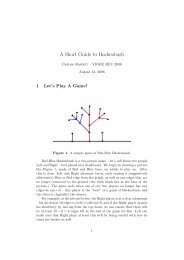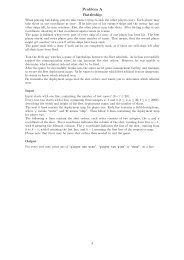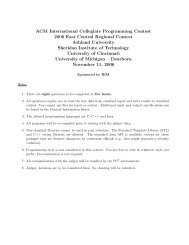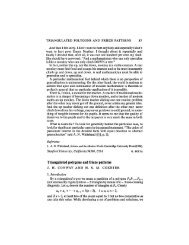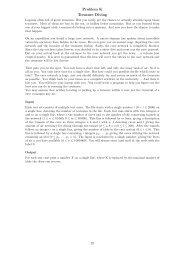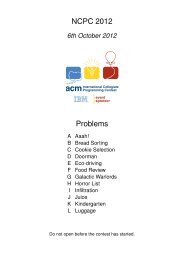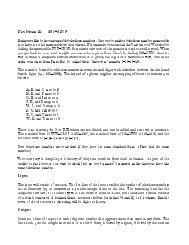Review1 of Liber De Ludo Aleae (Book on Games of Chance) by ...
Review1 of Liber De Ludo Aleae (Book on Games of Chance) by ...
Review1 of Liber De Ludo Aleae (Book on Games of Chance) by ...
Create successful ePaper yourself
Turn your PDF publications into a flip-book with our unique Google optimized e-Paper software.
Cardano especially warns that lawyers, doctors and those in like pr<str<strong>on</strong>g>of</str<strong>on</strong>g>essi<strong>on</strong>s avoid gambling, which could<br />
be injurious to their reputati<strong>on</strong>s and business. Interestingly, he adds:<br />
“Men <str<strong>on</strong>g>of</str<strong>on</strong>g> these pr<str<strong>on</strong>g>of</str<strong>on</strong>g>essi<strong>on</strong>s incur the same judgement if they wish to practice music.”<br />
In Chapter 6 Cardano presents what he refers to as the Fundamental Principle <str<strong>on</strong>g>of</str<strong>on</strong>g> Gambling:<br />
“The most fundamental principle <str<strong>on</strong>g>of</str<strong>on</strong>g> all in gambling is simply equal c<strong>on</strong>diti<strong>on</strong>s...<str<strong>on</strong>g>of</str<strong>on</strong>g> m<strong>on</strong>ey, <str<strong>on</strong>g>of</str<strong>on</strong>g><br />
situati<strong>on</strong>...and <str<strong>on</strong>g>of</str<strong>on</strong>g> the dice itself. To the extent to which you depart from that equality, if it is in your<br />
opp<strong>on</strong>ent’s favour, you are a fool, and if in your own, you are unjust.”<br />
What is most important for our purposes, is to recognise that Cardano’s fundamental principle states that<br />
games <str<strong>on</strong>g>of</str<strong>on</strong>g> chance can <strong>on</strong>ly be fairly played when there are equiprobable outcomes. This principle is the<br />
basis for his theory relating to outcomes in games <str<strong>on</strong>g>of</str<strong>on</strong>g> dice.<br />
Cardano begins to present (the results) <str<strong>on</strong>g>of</str<strong>on</strong>g> his theory <strong>on</strong> dice in Chapter 9: On the Cast <str<strong>on</strong>g>of</str<strong>on</strong>g> One Die. Given<br />
that a die has six points, he states:<br />
“...in six casts each point should turn up <strong>on</strong>ce; but since some will be repeated, it follows that others will<br />
not turn up.”<br />
We see here that his principle is at work (the symmetry <str<strong>on</strong>g>of</str<strong>on</strong>g> the die allows equiprobable outcomes), and<br />
also that he recognises (c<strong>on</strong>firmed <strong>by</strong> experience no doubt), that the principle is an ideal, and that in<br />
practice we will not have each point turn up <strong>on</strong>ce in every six casts. There would appear to be an implicit<br />
understanding <str<strong>on</strong>g>of</str<strong>on</strong>g> a “l<strong>on</strong>g range relative frequency” interpretati<strong>on</strong> <str<strong>on</strong>g>of</str<strong>on</strong>g> “in six casts each point should turn<br />
up <strong>on</strong>ce”. Or, in the c<strong>on</strong>temporary language <str<strong>on</strong>g>of</str<strong>on</strong>g> probability theory, we would say that we expect in six<br />
casts each point should turn up <strong>on</strong>ce.<br />
In this chapter, the c<strong>on</strong>cepts referred to as “circuit” and “equality” are introduced:<br />
“One-half <str<strong>on</strong>g>of</str<strong>on</strong>g> the total number <str<strong>on</strong>g>of</str<strong>on</strong>g> faces always represents equality; thus the chances are equal that a given<br />
point will turn up in three throws, for the total circuit is completed in six, or again that <strong>on</strong>e <str<strong>on</strong>g>of</str<strong>on</strong>g> three given<br />
points will turn up in <strong>on</strong>e throw. For example, I can as easily throw <strong>on</strong>e, three, or five as two, four, or<br />
six.”<br />
The “circuit” refers to the number <str<strong>on</strong>g>of</str<strong>on</strong>g> possible (elementary) outcomes, what in c<strong>on</strong>temporary probability<br />
theory may be referred to as “the size <str<strong>on</strong>g>of</str<strong>on</strong>g> the sample space”. “Equality” appears to be a c<strong>on</strong>cept related to<br />
expectati<strong>on</strong>. Since a given point <strong>on</strong> a die is expected to turn up <strong>on</strong>ce in six throws (the circuit), it could<br />
equally turn up in the first or sec<strong>on</strong>d three casts. Cardano also provides a variati<strong>on</strong> <strong>on</strong> this interpretati<strong>on</strong>,<br />
indicating that in <strong>on</strong>e throw, three given points (1,3,5) could turn up as easily as the three other points<br />
(2,4,6). Equality then can be understood as defined, that is, <strong>on</strong>e-half <str<strong>on</strong>g>of</str<strong>on</strong>g> the circuit, or as (in c<strong>on</strong>temporary<br />
terms) an event, which is as likely as its complementary event (that is, an event with probability <strong>on</strong>e-half).<br />
Pr<str<strong>on</strong>g>of</str<strong>on</strong>g>essor Ore suggests that the c<strong>on</strong>cept <str<strong>on</strong>g>of</str<strong>on</strong>g> equality is a c<strong>on</strong>sequence <str<strong>on</strong>g>of</str<strong>on</strong>g> Cardano having “the practical<br />
game in mind”:<br />
“...he seems to assume that usually there are <strong>on</strong>ly two [players]...each will stake the same amount A so<br />
that the whole pot is P = 2A. When a player c<strong>on</strong>siders how much he has w<strong>on</strong> or lost it is natural to relate<br />
it not to the whole pot 2A but to his own stake A. In terms <str<strong>on</strong>g>of</str<strong>on</strong>g> such a measure his expectati<strong>on</strong> becomes<br />
2




